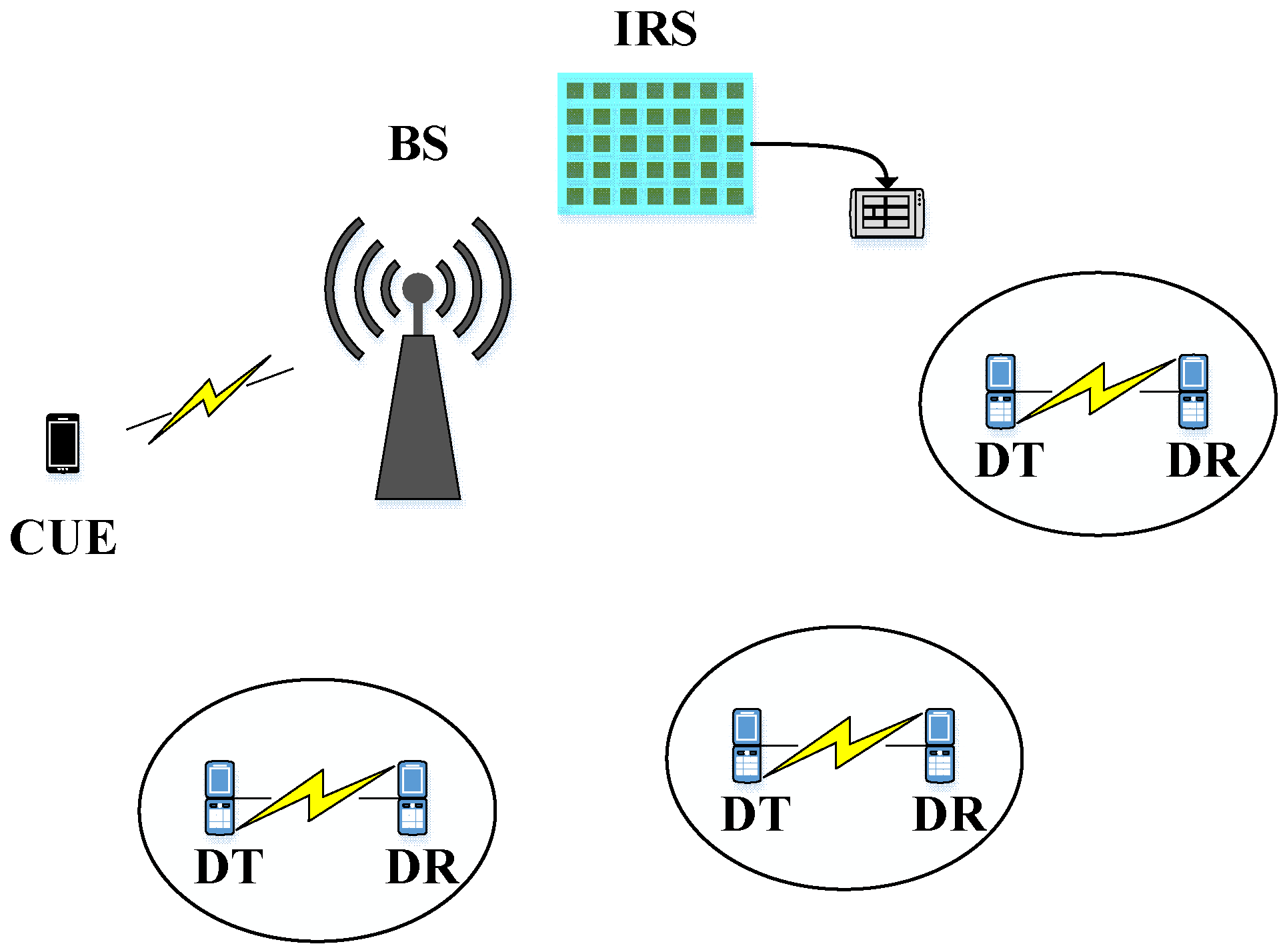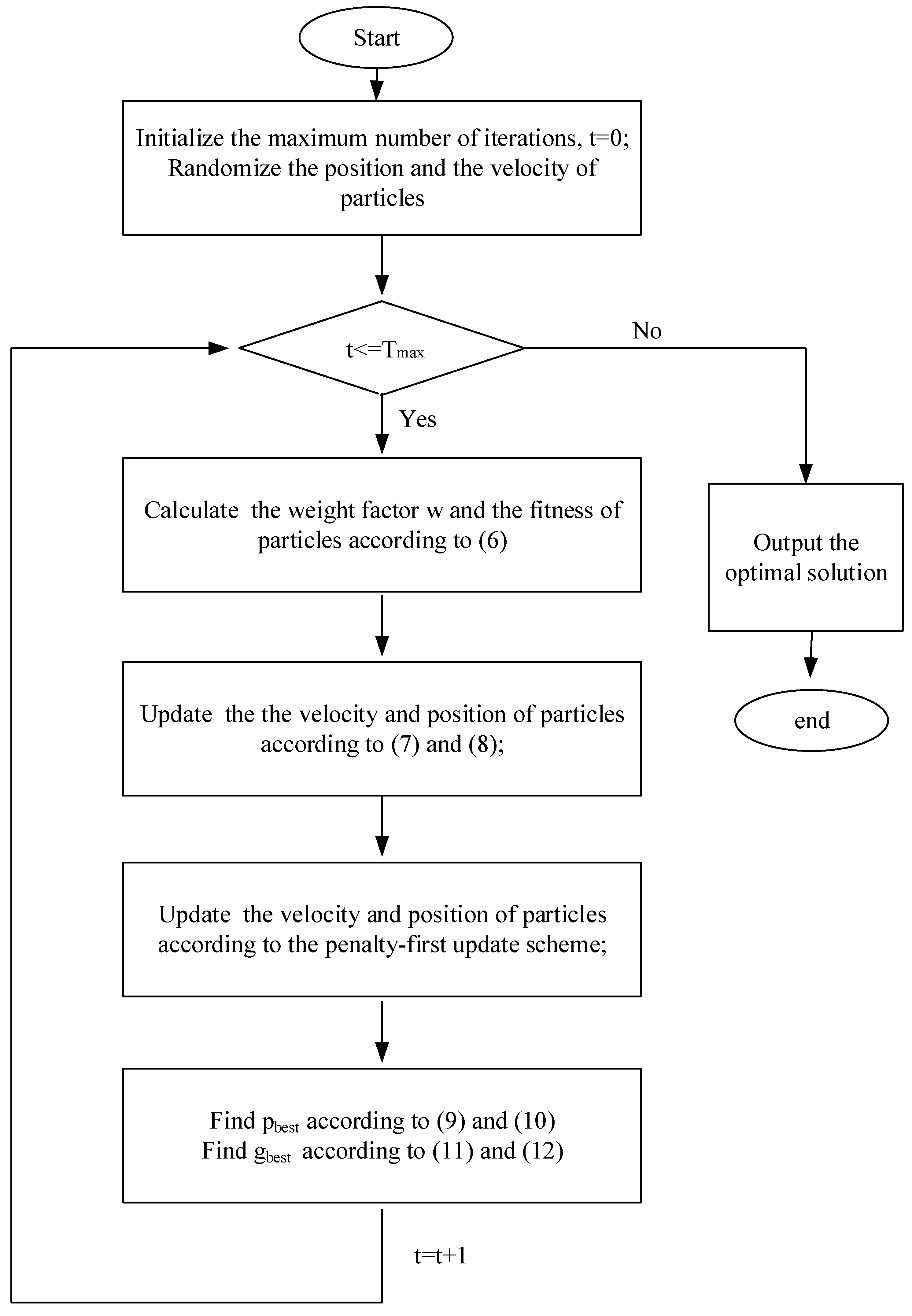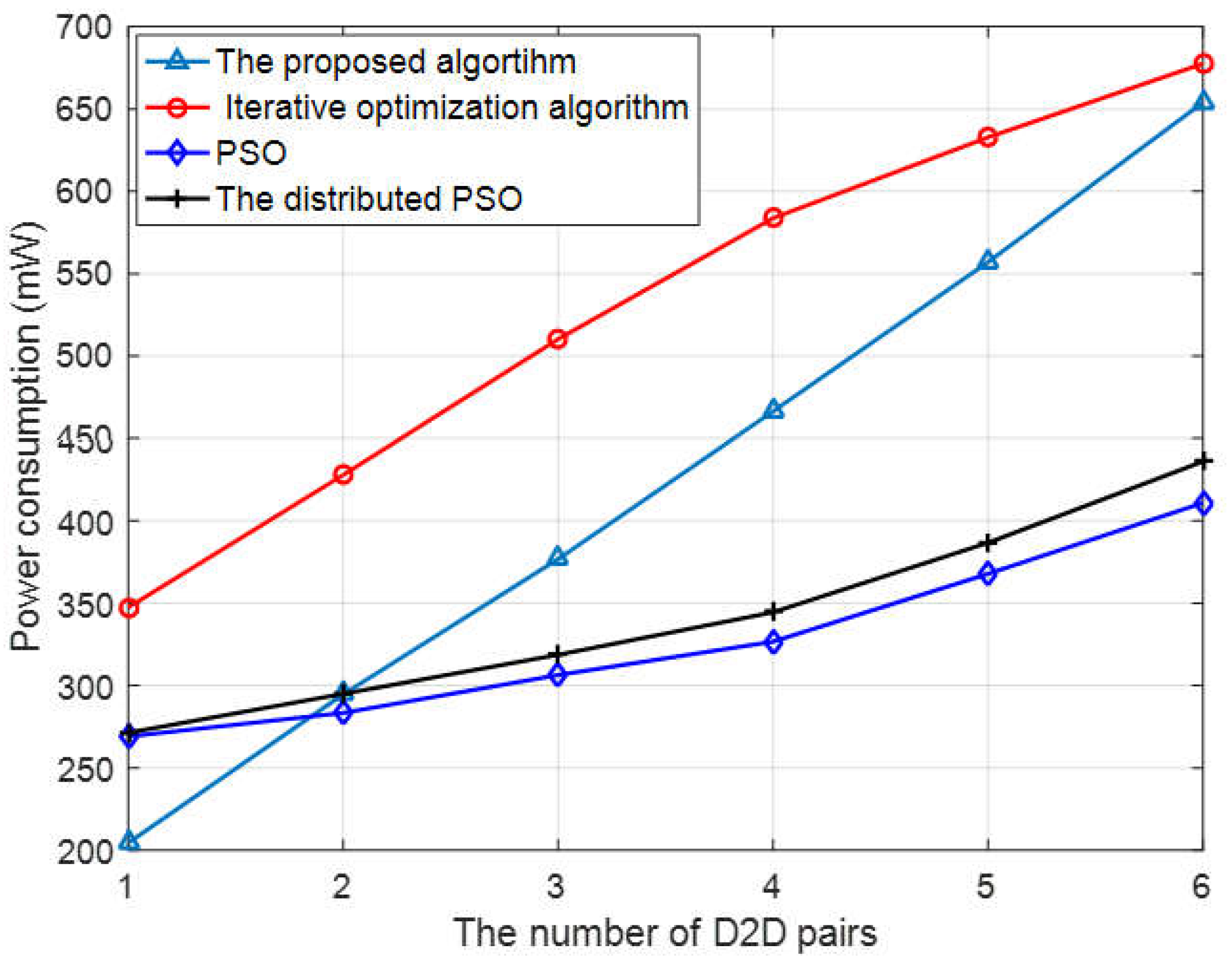Joint Particle Swarm Optimization of Power and Phase Shift for IRS-Aided D2D Underlaying Cellular Systems
Abstract
1. Introduction
- (1)
- To optimize the sum rate for IRS-assisted D2D communication underlying cellular systems, we establish an optimal function that takes into account power allocation and phase shift allocation while satisfying transmission power range and minimum data rate constraints;
- (2)
- The proposed multivariable optimization problem is non-convex and nonlinear, so it is difficult to solve directly. To this end, we propose a low-complexity PSO-based wireless radio resource allocation. Different from the existing work, the proposed method does not need to decompose the optimization problem into multiple subproblems and optimize them separately, which avoids high complexity. In addition, unlike previous applications of PSO, in this paper, the PSO algorithm is used to optimize the transmit power and phase shift simultaneously, which has not been covered before;
- (3)
- We analyze the performance of the proposed algorithm in terms of sum rate, power consumption, and convergence through simulations to verify its effectiveness. In addition, we provide a complexity analysis.
2. System Model and Problem Description
3. Joint Optimization Algorithm of Power and Phase Shift Based on PSO
3.1. Basic Concept of PSO
3.2. The Process of PSO Algorithm
| Algorithm 1. PSO algorithm. |
| Step 1: Initialization |
| Initialize the population size (the number of particles in the population), the number of iterations, the effective position range, the effective velocity range, and the initial position and velocity of each particle. |
| Step 2: Evaluate the fitness of each particle according to the fitness function |
| The fitness function is the objective function of the algorithm optimization, and the function value calculated by bringing the attributes of the particle into the fitness function is the fitness of the particle. |
| Step 3: Find and |
| For each particle, its current fitness is compared with the fitness corresponding to its individual historical best position (). If the current fitness value is higher, the individual historical best position is updated to the current position. |
| For each particle, its current fitness is compared with the fitness corresponding to the global best position (). If the current fitness is higher, the global best position is updated to the current particle position. |
| Step 4: Update particle attribute |
| Update the velocity and position of each particle according to the update formula [19]. |
| The Common update formulas are as follows: |
| where represents the velocity of particle at time, represents the position of particle at time, is the velocity of the particle at the next time, and is the position of the particle at the next time. Particle is the individual historical optimal value of particle at time, is the global optimal value at time, and are learning factors, and particle denotes a random number between 0 and 1. |
| If the iteration is complete, the algorithm stops; otherwise return to step 2. |
| Notice that searching the maximum total rate for the IRS-assisted D2D communication system is similar to the process of obtaining the global optimal location in the particle swarm optimization algorithm. Therefore, this section will design the PSO algorithm for the IRS-assisted D2D underlaying cellular communication systems to optimize the phase shift and power. |
3.3. The Proposed Power and Phase Shift Joint Optimization Algorithm
3.3.1. Fitness Function
3.3.2. Update Formula
3.3.3. Penalty-First Update Scheme
- ■
- Update the velocity of particles
- ■
- Update the position of particles
- ■
- Updates of and
- The penalty value of the current solution of the particle is less than the penalty value of the historical optimal solution of the particle. That is,
- 2.
- The penalty value of the current solution of the particle is equal to the penalty value of the individual historical optimal solution of the particle, and the fitness value is greater than that of the individual historical optimal solution. That is,
- The current penalty value of the individual particle solution is less than that of the population optimal solution. That is, for the current time t, and individual particle
- 2.
- The penalty value of the current particle individual solution is equal to the penalty value of the population optimal solution, and the fitness value is greater than the fitness value of the population optimal solution. That is,
| Algorithm 2. Power and Phase Shift Joint Optimization Algorithm Based on PSO. |
Initialization: randomly generate the initial velocity and position of the population, set and
|
3.4. Complexity Analysis
4. Simulation Results and Analysis
5. Conclusions
6. Future Research
- (a)
- Study the number and location of IRS and analyze the impact of these factors on performance to further explore the potential of IRS-assisted D2D communication systems;
- (b)
- There are many different domains where advanced optimization algorithms have been applied as solution approaches, such as online learning, multi-objective optimization, and others. In our future work, we will explore advanced optimization algorithms (e.g., adaptive heuristics and metaheuristics, self-adaptive algorithms, diffused algorithms, island algorithms, etc.) [25,26,27]. Moreover, the PSO approach adopted in this study can be compared with these advanced optimization algorithms;
- (c)
- In this paper, we only consider the radio resource allocation when the channel state information (CSI) is perfect. In future work, the optimization problems under the condition of imperfect CSI should also be considered.
Author Contributions
Funding
Institutional Review Board Statement
Informed Consent Statement
Data Availability Statement
Conflicts of Interest
References
- Huang, C.; Mo, R.; Yuen, C. Reconfigurable Intelligent Surface Assisted Multiuser MISO Systems Exploiting Deep Reinforcement Learning. IEEE J. Sel. Areas Commun. 2020, 38, 1839–1850. [Google Scholar] [CrossRef]
- Jung, M.; Saad, W.; Jang, Y.; Kong, G.; Choi, S. Reliability analysis of large intelligent surfaces (LISs): Rate distribution and outage probability. IEEE Wirel. Commun. Lett. 2019, 8, 1662–1666. [Google Scholar] [CrossRef]
- Salim, D.; Samuh, M.H.; Salhab, A.M. RIS source decode-and-forward relaying network with interference. Phys. Commun. 2021, 47, 101333. [Google Scholar] [CrossRef]
- Basar, E. Transmission Through Large Intelligent Surfaces: A New Frontier in Wireless Communications. In Proceedings of the European Conference on Networks and Communications (EuCNC), Valencia, Spain, 18–21 June 2019. [Google Scholar]
- Huang, C.; Zappone, A.; Alexandropoulos, G.C.; Debbah, M.; Yuen, C. Reconfigurable intelligent surfaces for energy efficiency in wireless communication. IEEE Trans. Wirel. Commun. 2019, 18, 4157–4170. [Google Scholar] [CrossRef]
- Chen, J.; Liang, Y.C.; Pei, Y.; Guo, H. Intelligent reflecting surface: A programmable wireless environment for physical layer security. IEEE Access 2019, 7, 82599–82612. [Google Scholar] [CrossRef]
- Di, B.; Zhang, H.; Song, L.; Li, Y.; Han, Z.; Poor, H.V. Hybrid Beamforming for Reconfigurable Intelligent Surface based Multi-User Communications: Achievable Rates with Limited Discrete Phase Shifts. IEEE J. Sel. Areas Commun. 2020, 38, 1809–1822. [Google Scholar] [CrossRef]
- Li, S.; Duo, B.; Yuan, X.; Liang, Y.C.; Di Renzo, M. Reconfigurable intelligent surface assisted UAV communication: Joint trajectory design and passive beamforming. IEEE Wirel. Commun. Lett. 2020, 9, 716–720. [Google Scholar] [CrossRef]
- Zhang, C.; Chen, W.; He, C.; Li, X. Throughput maximization for intelligent reflecting surface-aided device-to-device communications system. J. Commun. Inf. Netw. 2020, 5, 403–410. [Google Scholar] [CrossRef]
- Khoshafa, M.H.; Ngatched, T.M.N.; Ahmed, M.H. Reconfigurable intelligent surfaces-aided physical layer security enhancement in D2D underlay communications. IEEE Commun. Lett. 2021, 25, 1443–1447. [Google Scholar] [CrossRef]
- Mao, S.; Chu, X.; Wu, Q.; Liu, L.; Feng, J. Intelligent reflecting surface enhanced D2D cooperative computing. IEEE Wirel. Commun. Lett. 2021, 10, 1419–1423. [Google Scholar] [CrossRef]
- Jia, S.; Yuan, X.; Liang, Y.C. Reconfigurable intelligent surfaces for energy efficiency in D2D communication network. IEEE Wirel. Commun. Lett. 2021, 10, 683–687. [Google Scholar] [CrossRef]
- Yang, G.; Liao, Y.; Liang, Y.C.; Tirkkonen, O.; Wang, G.; Zhu, X. Reconfigurable intelligent surface empowered device-to-device communication underlaying cellular networks. IEEE Trans. Commun. 2021, 69, 7790–7805. [Google Scholar] [CrossRef]
- Cheng, J.; Shen, C.; Chen, Z.; Pappas, N. Robust Beamforming Design for IRS-Aided URLLC in D2D Networks. IEEE Trans. Commun. 2022, 70, 6035–6049. [Google Scholar] [CrossRef]
- Han, B.; Chen, X.; Guo, D.; Jiao, L. Intelligent Reflecting Surface Enabled in D2D Millimeter Wave Communication. In Proceedings of the 2022 IEEE International Conference on Smart Internet of Things (SmartIoT), Suzhou, China, 19–21 August 2022; pp. 86–93. [Google Scholar]
- Wang, W.; Yang, L.; Meng, A.; Zhan, Y.; Ng, D.W.K. Resource Allocation for IRS-Aided JP-CoMP Downlink Cellular Networks with Underlaying D2D Communications. IEEE Trans. Wirel. Commun. 2022, 21, 4295–4309. [Google Scholar] [CrossRef]
- Xu, F.; Ye, Z.; Cao, H.; Hu, Z. Sum-Rate Optimization for IRS-Aided D2D Communication Underlaying Cellular Networks. IEEE Access 2022, 10, 48499–48509. [Google Scholar] [CrossRef]
- Kennedy, J.; Eberhart, R. Particle swarm optimization. In Proceedings of the IC NN’95-International Conference on Neural Networks, Perth, WA, Australia, 27 November–1 December 1995; Volume 4, pp. 1942–1948. [Google Scholar]
- Coello Coello, C.A.; Pulido, G.T.; Lechuga, M.S. Handling multiple objectives with particle swarm optimization. IEEE Trans. Evol. Comput. 2004, 8, 256–279. [Google Scholar] [CrossRef]
- Lin, Q.; Li, J.; Du, Z.; Chen, J.; Ming, Z. A novel multi-objective particle swarm optimization with multiple search strategies. Eur. J. Oper. Res. 2015, 247, 732–744. [Google Scholar] [CrossRef]
- Chen, R.; Xu, J. Particle Swarm Optimization Based Power Allocation for D2D Underlaying Cellular Networks. In Proceedings of the 17th IEEE International Conference on Communication Technology, Chengdu, China, 27–30 October 2017; pp. 503–507. [Google Scholar]
- Lye, S.C.K.; Yew, H.T.; Chua, B.L.; Chin, R.K.Y.; Teo, K.T.K. Particle Swarm Optimization Based Resource Allocation in Orthogonal Frequency-division Multiplexing. In Proceedings of the 2013 7th Asia Modelling Symposium, Hong Kong, China, 23–25 July 2013; pp. 303–308. [Google Scholar]
- Zhao, Y.; Li, X.; Li, Y.; Ji, H. Resource allocation for high velocity railway downlink MIMO-OFDM system using quantum behaved particle swarm optimization. In Proceedings of the 2013 IEEE International Conference on Communications (ICC), Budapest, Hungary, 9–13 June 2013; pp. 2343–2347. [Google Scholar]
- Gong, W.; Wang, X. Particle Swarm Optimization Based Power Allocation Schemes of Device-to-Device Multicast Communication. Wirel. Pers. Commun. 2015, 85, 1261–1277. [Google Scholar] [CrossRef]
- Deng, X.; Li, M.; Deng, S.; Wang, L. Hybrid gene selection approach using XGBoost and multi-objective genetic algorithm for cancer classification. Med. Biol. Eng. Comput. 2022, 60, 663–681. [Google Scholar] [CrossRef]
- Kavoosi, M.; Dulebenets, M.A.; Abioye, O.; Pasha, J.; Mikijeljevi, M. Berth scheduling at marine container terminals: A universal island-based metaheuristic approach. Marit. Bus. Rev. 2020, 5, 30–66. [Google Scholar] [CrossRef]
- Gholizadeh, H.; Fazlollahtabar, H. Preventive maintenance for the flexible flowshop scheduling under uncertainty: A waste-to-energy system. Environ. Sci. Pollut. Res. 2021. Online ahead of print. [Google Scholar] [CrossRef] [PubMed]







| Symbol and Meaning | Value |
|---|---|
| Number of users I | 2:1:7 |
| Number of IRS elements N | 16 |
| Number of bits quantized by the IRS element e | 4 |
| Bandwidth of the system | 28 GHz |
| Noise power spectral density | −134 dBm/Hz |
| Number of Population particle M | 80 |
| Iteration times T | 200 |
| Upper power limit of the users | 200 mW |
| Inertia weight factor | 0.9 |
| Inertia weight factor | 0.4 |
| The minimum rate of the users | 1.58 bps/Hz |
| Learning factor | 1.49445 |
| −10 | |
| 10 | |
Disclaimer/Publisher’s Note: The statements, opinions and data contained in all publications are solely those of the individual author(s) and contributor(s) and not of MDPI and/or the editor(s). MDPI and/or the editor(s) disclaim responsibility for any injury to people or property resulting from any ideas, methods, instructions or products referred to in the content. |
© 2023 by the authors. Licensee MDPI, Basel, Switzerland. This article is an open access article distributed under the terms and conditions of the Creative Commons Attribution (CC BY) license (https://creativecommons.org/licenses/by/4.0/).
Share and Cite
Wang, R.; Wen, X.; Xu, F.; Ye, Z.; Cao, H.; Hu, Z.; Yuan, X. Joint Particle Swarm Optimization of Power and Phase Shift for IRS-Aided D2D Underlaying Cellular Systems. Sensors 2023, 23, 5266. https://doi.org/10.3390/s23115266
Wang R, Wen X, Xu F, Ye Z, Cao H, Hu Z, Yuan X. Joint Particle Swarm Optimization of Power and Phase Shift for IRS-Aided D2D Underlaying Cellular Systems. Sensors. 2023; 23(11):5266. https://doi.org/10.3390/s23115266
Chicago/Turabian StyleWang, Ruijie, Xun Wen, Fangmin Xu, Zhijian Ye, Haiyan Cao, Zhirui Hu, and Xiaoping Yuan. 2023. "Joint Particle Swarm Optimization of Power and Phase Shift for IRS-Aided D2D Underlaying Cellular Systems" Sensors 23, no. 11: 5266. https://doi.org/10.3390/s23115266
APA StyleWang, R., Wen, X., Xu, F., Ye, Z., Cao, H., Hu, Z., & Yuan, X. (2023). Joint Particle Swarm Optimization of Power and Phase Shift for IRS-Aided D2D Underlaying Cellular Systems. Sensors, 23(11), 5266. https://doi.org/10.3390/s23115266





